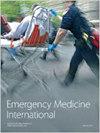ICD-10 Classification in the Practice of Emergency Medical Teams: New Insights
IF 1.2
4区 医学
Q3 EMERGENCY MEDICINE
引用次数: 0
Abstract
The role of the emergency medical system is to provide assistance to every person in a state in the event of a sudden threat to health and life. Emergency medical teams (EMTs) are an important element of this system, making diagnoses based on the International Classification of Diseases (ICD-10). The study was aimed at analysing the causes of EMT intervention based on groups of diagnoses codified according to the ICD-10. The analysis was based on data from 116,278 EMT interventions in central-eastern Poland in 2017-2019. The research showed that EMT most often made diagnoses based on groups of ICD-10 codes: R00-R99-Symptoms, signs, and abnormal clinical and laboratory findings, not elsewhere classified (39.11%); S00-T98-Injury, poisoning, and certain other consequences of external causes (18.23%); and I00-I99-Diseases of the circulatory system (15.57%). The analysis of the obtained results showed statistically significant differences (p<0.0001) regarding the area of intervention (urban, rural), sex, age of the patient, and the method of completion of the activities by EMTs in relation to the group of ICD-10 diagnoses for the diagnosis. The conducted study showed the actual reasons for EMT calls. The use of the ICD-10 classification has practical application in EMTs, as it enables the identification of a disease or health problem.急救医疗队实践中的 ICD-10 分类:新见解
紧急医疗系统的作用是在健康和生命突然受到威胁时,为州内的每个人提供援助。急救医疗队(EMT)是这一系统的重要组成部分,根据《国际疾病分类》(ICD-10)进行诊断。这项研究旨在根据 ICD-10 编纂的诊断组别,分析急救医疗队干预的原因。分析基于 2017-2019 年波兰中东部地区 116,278 例 EMT 干预的数据。研究表明,急诊医学最常根据 ICD-10 编码组进行诊断:R00-R99-症状、体征、异常临床和实验室结果,未在别处分类(39.11%);S00-T98-损伤、中毒和某些其他外因后果(18.23%);I00-I99-循环系统疾病(15.57%)。对所得结果的分析表明,在干预地区(城市、农村)、性别、患者年龄和急救医生完成活动的方法方面,与 ICD-10 诊断的诊断组别有关的差异具有统计学意义(P<0.0001)。所进行的研究显示了急救医生出诊的实际原因。ICD-10 分类法的使用在急救医疗人员中具有实际应用价值,因为它可以确定疾病或健康问题。
本文章由计算机程序翻译,如有差异,请以英文原文为准。
求助全文
约1分钟内获得全文
求助全文
来源期刊

Emergency Medicine International
EMERGENCY MEDICINE-
CiteScore
0.10
自引率
0.00%
发文量
187
审稿时长
17 weeks
期刊介绍:
Emergency Medicine International is a peer-reviewed, Open Access journal that provides a forum for doctors, nurses, paramedics and ambulance staff. The journal publishes original research articles, review articles, and clinical studies related to prehospital care, disaster preparedness and response, acute medical and paediatric emergencies, critical care, sports medicine, wound care, and toxicology.
 求助内容:
求助内容: 应助结果提醒方式:
应助结果提醒方式:


